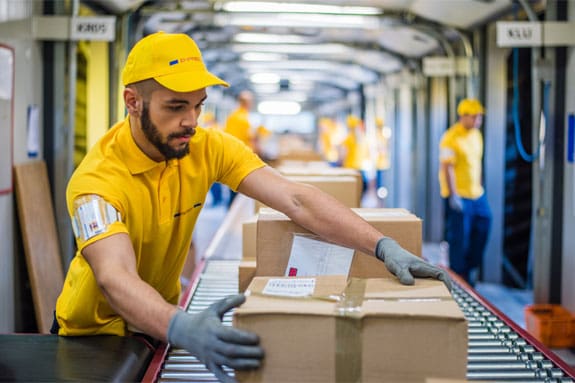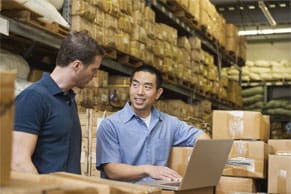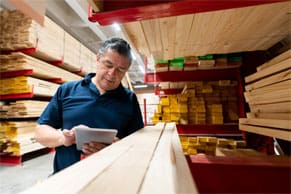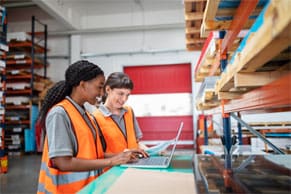Businesses of all sizes rely on global supply chains to source materials and deliver products in today’s economy. As supply chains continue to evolve, businesses often struggle with maintaining the visibility they need to avoid major disruptions that can result in empty shelves and unhappy customers. Many companies turn to supply chain control towers to help address that complexity. Much like the way air traffic control towers monitor and manage the tens of thousands of flights that arrive and depart airports each day, supply chain control towers monitor and manage the flow of goods, materials and information from one end of the supply chain to the other. With a supply chain control tower, businesses can mitigate risks, make better-informed decisions, gain real-time visibility into operations and more.
What Is a Supply Chain Control Tower?
A supply chain control tower is a centralized, cloud-based system that automatically collects and integrates data from across a company’s supply chain — from barcodes, remote sensors and the Internet of Things (IoT) to weather and traffic data — to provide real-time information and insights. It gives supply chain managers and business leaders end-to-end visibility into supply chain processes — logistics, fulfillment, inventory management, delivery and everything in between — by creating a single hub for decision-makers to view key business metrics and data from multiple sources, often through customizable and easy-to-understand dashboards. These virtual control towers are often integrated with a business’s internal systems, such as transportation management systems (TMS), warehouse management systems (WMS) and enterprise resource planning (ERP) systems, to achieve the primary goals of a supply chain control tower — to make better informed decisions, reduce costs and inefficiencies and give customers a faster and more reliable experience.
Key Takeaways
- Supply chain control towers centralize a company’s supply chain data to give business leaders increased visibility and more control over operations.
- Supply chain control towers can be used to focus on specific parts of the supply chain or take a holistic approach. Companies that understand the available options can create purpose-built control towers that best suit their business needs.
- Control towers can help businesses manage complex and global supply chains, but they are not without risks. Businesses still must put contingency plans in place to prevent costly disruptions and slowdowns.
Supply Chain Control Towers Explained
Supply chain control towers act as a virtual headquarters where all supply chain data is stored, organized and analyzed. This is achieved by integrating a business’s siloed or disparate operations and using collaboration tools to easily share information and communicate with partners. For example, the U.S. Department of Health and Human Services uses a supply chain control tower to help manage and analyze the supply and demand of personal protective equipment. According to the 2022 Economic Report of the President by the Council of Economic Advisers, “The department’s Supply Chain Control Tower receives near-daily data from distributors that represent more than 80 percent of the volume for the commodities it is tracking, along with supply status from 5,000 hospitals. This dashboard alleviates hospitals’ fear of shortages, so they do not need to incur extra costs of holding inventory. The dashboard also allows distributors to receive a truer demand signal by reducing excessive ordering that exacerbates supply constraints.”
A supply chain control tower’s connectivity helps to ensure up-to-date, accurate data and often leverages advanced technology, such as artificial intelligence (AI) and machine learning (ML), to achieve a more effective data collection and analysis process. Supply chain control towers use key performance indicators (KPIs), including supplier performance, inventory levels, delivery tracking and other metrics, to automatically alert businesses to any supply chain disruptions or complications. Businesses often use this information to find inefficiencies, more effectively identify potential risks and prioritize the most critical fixes. Sophisticated towers can use this data to create scenario simulations and help business leaders plan for forecasted demand or supply changes. The supply chain control tower can help companies create and maintain the flexibility needed to quickly adapt to fluctuations in customer demand — contributing to a streamlined supply chain, increased revenue and improved customer satisfaction.
Key Capabilities of Supply Chain Control Towers
Supply chain control towers are not one size fits all and can — and should — be purpose-built to suit a business’s needs. But most businesses looking for a supply chain control tower will likely benefit from these key capabilities.
- Real-time visibility: Control towers can integrate data from siloed or external areas of a business to track the flow of goods, inventory status and more to give end-to-end visibility to relevant parties. This visibility is often achieved through leveraging modern technology, such as IoT devices, that can track goods and materials and give detailed status updates for items moving through the supply chain.
- Data collection and analytics: By collecting and analyzing large amounts of data, supply chain control towers can typically give faster and more detailed reports than manual analysts by using technology, such as ML and automated data collection and validation. Reports are compiled into customizable dashboards to keep data organized and accessible and give decision-makers insights on performance, trends and potential risks to help them make informed decisions that strengthen and improve operations.
- Increased collaboration: Collaboration among internal teams and with external parties is critical to maintaining an efficient supply chain. Many control towers come with collaborative spaces and digital conference rooms to help stakeholders quickly resolve unexpected issues and improve operations. And because control towers can be integrated across a supply chain, they can quickly alert businesses to any disruptions or issues by creating an accessible and open channel of communication with external partners, such as vendors and distributors.
- Planning and forecasting: Control towers are often capable of daily operational planning and longer-term demand forecasts, especially when integrated with an ERP system. Control towers use powerful scenario modeling to predict both upstream and downstream impacts of changes in the supply chain and can offer actionable suggestions, automatic flagging of problem areas and prescriptive support to mitigate risks and prepare for the future. Businesses can use these tools to gain an advantage over competitors scrambling to keep up with new disruptions or unexpected demand fluctuations.
Key Capabilities of Supply Chain Control Towers
Real-time visibility into operations
|
Data collection and analytics
|
Increased collaboration
|
Planning and forecasting
|
Types of Supply Chain Control Towers
Control towers are constantly evolving and adapting to meet new market challenges. According to Grand View Research data(opens in a new tab), the supply chain control tower market is expected to experience a 21.3% compound annual growth rate from 2023 to 2030, primarily driven by the increased need for businesses to “digitalize their supply chain processes.” With the growing popularity of control tower technology, it is important for businesses to choose the right solution to maximize its benefits. Here are some of the most common types of supply chain control towers.
Logistics and Transportation
Logistics and transportation control towers provide visibility and insight into inbound and outbound shipment logistics and are typically integrated with transportation management systems. These control towers can be customized with automatic alerts for specific issues, such as slowdowns, disruptions or shipment notifications. Advanced shipment notices can include weights and dimensions of goods to help businesses prepare for arrivals and create a more efficient receiving and storage operation. Businesses rely on logistics and transportation control towers to reduce costs, streamline deliveries and speed up their supply chain operations.
Fulfillment
Fulfillment control towers focus on getting orders to customers quickly and accurately by assisting with shipment picking, packing and delivery. They can be integrated with ecommerce platforms to improve the ordering process for customers and decrease the time between order placement and fulfillment. Fulfillment control towers enable real-time monitoring of goods, giving both businesses and customers increased visibility into order status and estimated delivery times, often through automatic alerts. Businesses looking to improve customer satisfaction and create a more efficient ordering process may benefit from a fulfillment supply chain control tower.
Inventory
Inventory control towers improve inventory visibility and help mitigate the risks of stockouts and overstocks by maintaining up-to-date inventory data and automatically flagging accounts when inventory levels go outside a predetermined range. This helps businesses meet customer demand while minimizing carrying costs. These control towers can also help track and maintain appropriate stock levels for perishable or temporary goods, reducing waste and unsold goods. Inventory control towers are often integrated with warehouse management systems to ensure optimized storage space and efficient inventory stocking and counting processes. Businesses with a high inventory turnover rate or volatile demand often choose inventory-focused supply chain control towers.
Supply Assurance
Without supplies, companies cannot produce their goods. Supply assurance towers manage the flow of supplies and raw materials into the business. These towers track supply levels and monitor supplier performance through measures that include on-time delivery and raw material quality. They can also reduce vulnerabilities during procurement by ensuring supplier continuity in the face of disruptions and making certain that the business has enough raw materials on hand to continue production. Supply assurance control towers can be valuable tools for companies that require extensive and diverse supply deliveries.
E2E Supply Chain
Modern supply chains require greater visibility to be managed effectively, increasing the importance of end-to-end visibility, especially for global companies. According to Nucleus Research’s Control Tower Technology Value Matrix 2022(opens in a new tab) report, “Siloed Control Towers, planners and transportation analysts often find themselves bogged down… This methodology proves too slow to adjust to large volumes of supply chain exceptions.” To keep up with the fast-paced world of modern supply chains, “there is increased demand for end-to-end platforms that provide visibility and control to procurement, supplier relations, inventory allocation, production and transportation processes.” E2E supply chain control towers give business leaders detailed analysis and data from throughout the supply chain by pulling from internal and external data sources, leveraging AI and other modern technologies and integrating existing platforms, such as an ERP system. E2E control towers help companies take a holistic approach to their supply chain operations and strengthen the supply chain from procurement to final delivery.
Supply Chain Control Tower Data Types
Control towers collect, organize and analyze data from many sources, combining data from internal systems, partner networks and external sources to paint an extensive and detailed picture of the supply chain. Once all this data is centralized within the control tower, the system can present it to decision-makers and business leaders to help them understand and improve their processes. Each data source can inform reports in different ways, and understanding the differences can help validate and inform how the data is used.
Internal Systems
Much of the internal data in a supply chain control tower is pulled from various business systems — WMS, TMS, ERP, among others — and integrated into one centralized repository alongside external data sources. Control towers standardize this data to paint a complete picture of the supply chain that can be understood by stakeholders, analysts, managers and any other relevant parties. This internal data can be used to identify inefficiencies and vulnerabilities early, giving decision-makers time to fix issues before they become costly problems that affect customers and the bottom line.
Partner Networks
Collaboration is crucial to maintaining an effective supply chain operation, and control towers enable collaborators, such as suppliers and partners, to share information and find solutions together. By standardizing data entry and integrating data systems across business-to-business networks, problems can be identified quickly and resolved collaboratively, using expertise from multiple parties. For example, if a control tower identifies an upcoming supply shortage, it can automatically send notifications to procurement teams and vulnerable suppliers. Then, the business can work with vendors to identify an alternate solution or procurement method to ensure supply continuity. Quick responses to disruptions like these can be the difference between maintaining production rates or losing out to nimbler competitors.
External Data Sources
Control towers can use third-party information and data, including weather, global trade trends, transportation data and more, to inform decisions and prioritize risks. This data collection is often assisted by AI and ML to verify the data’s relevance and accuracy before it can influence reports and analysis. External data sources should be viewed with more skepticism than internally validated information, as they may be biased or inaccurate, but external data can be a critical tool when planning for disruptions, such as natural disasters and changes in international trade policies. Supply chain towers that combine internal and external data can inform contingency plans and more effectively mitigate risks than systems that rely on only one data source.
Supply Chain Control Tower Benefits
When effectively implemented, supply chain control towers can transform a business’s supply chain operations and reduce costs, increase productivity and maintain higher standards for customers. Here are some benefits of using supply chain control towers.
- Agility and flexibility: Control towers can facilitate a more flexible supply chain by quickly alerting decision-makers to obstructions, delays or external pressures that can disrupt processes, giving businesses more time to shift operations. And when there are external problems, such as material scarcity or transportation shutdowns, the most agile businesses are the most likely to get the resources they need to deliver for their customers. For ecommerce businesses, flexibility is critical as products can go viral overnight, and businesses unprepared for unexpected shifts in demand may be left with empty shelves while competitors’ sales skyrocket. Some control towers can create virtual collaborative spaces for teams to get together and quickly address any changes that need to be made to keep operations running smoothly and maintain supply continuity.
- Centralized data: When communicating — both among internal teams and with business partners — having a single source of information can keep everyone on the same page. This way, stakeholders can collaborate on well-informed decisions and ensure that everyone understands what, why and how future plans will be implemented. For example, in a siloed and disjointed supply chain operation, managers may make procurement decisions based on last week’s data, leading to understocked materials. But with a control tower’s centralized source of information, both manufacturing and procurement teams can see real-time data, such as supply levels and order status, to ensure that the proper materials are ordered when they’re needed, not after supplies run out.
- Digital playbooks: Digital playbooks are a set of best practices and standardized procedures that create a roadmap for managing the supply chain. They often include historical context for issues, previously attempted strategies and other institutional knowledge that helps managers compound successes and avoid repeating past failures. Digital playbooks can be hosted on the cloud for regular updating so that all staff, regardless of where they work, can access these strategies and implement them in their departments. Many modern digital playbooks are also integrated with AI to increase accessibility and speed up the time it takes to find relevant strategies when supply chain problems arise.
- Insights and recommendations: Many supply chain control towers run scenario analysis with predictive analytics to show how potential changes or external factors will impact the supply chain. Because control towers have access to far-reaching and robust data, their suggestions can be more insightful and detailed than siloed or narrow analysis. Recommendations can also be enhanced by AI, allowing business leaders to simulate situations, quickly find relevant information and identify root causes to prioritize risk management and plan for the future.
Supply Chain Control Tower Risks
Supply chain control towers can be powerful assets to a company, but they are not a one-and-done solution that can be set up once and forgotten. They require regular maintenance, monitoring and updating to ensure that everything is running properly. Below are some specific risks to watch out for after implementing a supply chain control tower.
- Data quality: Control towers require diverse data to effectively manage the supply chain, but not all data is created equal. If a supplier is self-reporting data, for example, it may be biased and inaccurate, leading to false conclusions and inappropriate strategies. Data must also be properly secured, especially when integrating the control tower with external partners, as a breach in one area can spread throughout a company. Businesses must be careful to ensure that data is accurate, relevant and secure to prevent knowledge gaps and cybersecurity breaches from compromising their supply chain.
- Efficacy of suggestions: Businesses do not have unlimited resources, and not every suggestion of what should be done to improve the supply chain is possible to implement. A control tower may lay out several fixes at once that all seem equally important to address, but decision-makers will still need to set their priorities — often based on cost, in both resources and time. Additionally, implementing fixes is often easier in theory than in practice, and businesses following every control tower suggestion without weighing the return on investment or potential complications may waste resources and create additional bottlenecks.
- Challenges in transforming the supply chain: Adding a supply chain control tower often requires large investments, including training and adapting staff to new technologies and practices. Seasoned employees used to old workflows may have trouble adjusting to new methods, and losing institutional knowledge and experience can create major problems for a business. Striking a balance between trying new best practices and using tried-and-true strategies is a common problem for modernizing businesses, and those implementing supply chain control towers are no exception.
- Overreliance on the software: While a supply chain control tower may use automation and advanced technologies, it still requires some level of hands-on expertise to reach its full potential. If a business doesn’t properly implement and integrate its control tower, it may not have the visibility needed to generate a realistic view of the supply chain as overreliance on software may obscure blind spots and weaknesses. Therefore, supply chain audits and on-staff experts should still conduct routine checks on the control tower’s reporting and the accuracy of the data it is collecting to ensure end-to-end visibility and optimized performance.
Access Real-Time Data, Analytics and Insights With NetSuite
As supply chains become increasingly global and more complex, effectively managing them presents new challenges for businesses. NetSuite Supply Chain Management software is a comprehensive solution for businesses to gain visibility into their supply chain operations, including procurement, production, distribution and delivery. NetSuite’s supply chain control tower collects real-time data to inform decision-making, monitor supplier performance, track inventory levels and more to ensure that customers get the right products in the right place at the right time.
NetSuite Supply Chain Planning software provides advanced forecasting and planning capabilities, allowing businesses to create accurate demand forecasts and optimize inventory levels. The software gives businesses the tools they need to proactively manage potential supply chain disruptions, such as bottlenecks or inventory shortages, and create contingency plans to mitigate their impact. With NetSuite, businesses can optimize their supply chain, reduce costs and improve customer satisfaction. NetSuite Supply Chain Management is scalable and can be integrated with other systems to help businesses stay ahead of the competition and be ready for tomorrow’s supply chain challenges.
As businesses expand globally, supply chains can quickly become too large and complex to manage manually. But with supply chain control towers, businesses can gain the end-to-end visibility and control they need to effectively manage their supply chain operations, from procurement to final delivery. By centralizing data from both internal teams and external sources, such as partners and suppliers, control towers can speed up the flow of goods and relieve bottlenecks before they begin affecting customer satisfaction. Companies can also use this data to inform recommendations and predictive analysis to help ensure that they use strategies that work best — and leave behind outdated methods. Supply chain control towers can help businesses get ahead of their competition and stay there, no matter what challenges future supply chains may face.
Supply Chain Control Tower FAQs
What is an inventory control tower?
Inventory control towers manage inventory levels across a business’s supply chain. They often include features like automatic alerts when disruptions occur or when inventory drops below predetermined levels. These towers integrate data from various sources and can be integrated with a warehouse management system to track the flow of goods, optimize inventory processes and reduce costs.
What is a control tower used for?
Supply chain control towers integrate various business systems and data sets to give companies more visibility into operations. This allows business leaders to quickly identify problems and target areas for improvements. Control towers are often assisted by artificial intelligence and machine learning to speed up processes and provide more meaningful insights to decision-makers.
What is a control tower in a supply chain?
A supply chain control tower centralizes information to give businesses more control over supply chain operations. It provides insights and recommendations for easing bottlenecks, mitigating risks and preparing for forecasted changes in the supply chain. By leveraging control towers, businesses can reduce costs, raise productivity and increase customer service.
What is a TMS control tower?
A transportation management system (TMS) control tower provides businesses with visibility for transportation operations. It monitors and manages transportation processes, such as planning and tracking, from a single, centralized platform. The TMS control tower uses internal and external data to optimize routing, reduce transportation costs and improve on-time delivery rates. Businesses can use TMS control towers to automate and streamline transportation processes, improve customer satisfaction and reduce costs.
How can a control tower help you achieve end-to-end visibility?
A control tower can help businesses achieve end-to-end visibility by providing a centralized system that integrates data from throughout an organization to create a comprehensive view of operations, often through easy-to-understand dashboards and reports. The control tower allows businesses to monitor and manage activities in real-time, giving leaders the tools to quickly identify potential issues or bottlenecks before they become major problems. By analyzing data from external sources, such as suppliers and distributors, businesses can use control towers to see every part of their end-to-end supply chain.
What are the considerations when deploying a control tower?
When deploying a control tower, businesses need to consider several factors, including scalability, alignment with company goals and the ability to integrate with existing systems. Businesses deploying a control tower should first coordinate with IT teams and third-party vendors to ensure that the system can adapt to changes in the organization and the external environment. When the control tower is deployed, businesses should regularly audit and monitor the supply chain to ensure that the control tower is realizing its potential and operating effectively.
What is the difference between an analytical control tower and an operational control tower?
An analytical control tower focuses on providing insights through historical data and predictive analytics to support strategic decision-making. Operational control towers are focused on real-time data from business processes to improve operational efficiency, reduce costs and enhance customer satisfaction. Both types can contribute to effective supply chain management, and they can be used together to provide a comprehensive view of operations.









